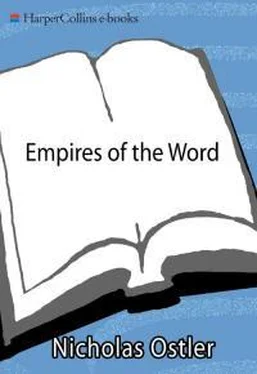Reynolds and Wilson (1968: 120).
Febvre and Martin (1976: 248-9).
ibid.: 289-95.
Anderson (1991: 39-41).
Herodotus, iv.106; Strabo, iv.5.4.
’E certifico a vuestra alteza que yo conté desde una mezquita cuatrocientos treinta y tantas tones en la dicha ciudad, y todas son de mezquitas.’ Cortés, Cartas de Relación de la Conquista de México, Carta Segunda (1982, Madrid: Espasa Calpe, 7th edn, p. 50).
Joseph de Acosta, The Natural and Moral History of the Indies , i, p. 160 (quoted in Crosby 1972: 38).
’…pareció al Almirante que debía llevar a Castilla … algunos indios paraque aprendiesen la lengua de Castilla y saber dellos los secretos de la tierra, y para instruillos en las cosas de la fe …’ De las Casas (1957 [c.1530], i.46: 163). De las Casas, describing the events fifty years later, found this act unpardonable, since it amounted to kidnapping.
e.g. in Rosenblat (1964: 192-3).
Inca Garcilaso, according to Gómez (1995: 82).
Inca Garcilaso, according to Abbott (1996: 685).
Instrucción Real , 20 and 29 March 1503, to Nicolas Ovando, in Collección de documentos inéditos del Archivo de Indias , xxxi, pp. 163-4.
This is described in, for example, Alvar (2000).
There is a list of noted mestizo generals and writers, especially historians, in Rosenblat (1964: 211).
Father Blas Valera’s words, quoted by Inca Garcilaso, Commentarios Reales , part I, vii.3: ’… La cual opinión ninguno que la oye deja de entender que nació antes de flaqueza de ánimo que torpeza de entendimiento.’
By Abbott (1996: 91).
Father Blas Valera’s words, quoted by Inca Garcilaso, Commentarios Reales , part I, vii.3: ‘ … porqué la semejanza y conformidad de las palabras casi siempre suelen reconciliar y traer a verdadera union y amistad a los hombres.’
Ricard (1933 [1966]: 23) says that in Mexico in 1559 there were 380 Franciscans, 210 Dominicans and 212 Augustinians. They were thinly spread: the average convent had five religious staff. Rosenblat (1964: 210) gives the then population of Mexico as 4.5 million, with the number of Spanish vecinos (heads of households) as 6,464.
La Paz (Bolivia) followed in 1610, Guatemala in 1660. Other major capitals in the Americas did not, however, begin to produce printed books until the eighteenth century, e.g. Bogotá in 1737, Buenos Aires in 1780 (Quilis 1992: 46-7). So for the Chibcha language, although it was officially constituted as the lengua general in New Granada, the first extant grammar had to be printed in Madrid in 1619. This was a serious problem for such technical publications in foreign languages, because the author, an ocean away from the printing house, would be unable to correct errors in the proofs, and the learners of course might well be misled by them.
Viñaza (1892). These could be compared with the Summer Institute for Linguistics’ estimate of the number of distinct languages in the Americas: 888, with 408 of them in South America (Harmon 1995: 26-7).
Rosenblat (1964: 191).
Sherzer (1993: 251).
Lara (1989: 99).
Lara (1971: 14) mentions a manuscript codex by Pedro Aparicio of 1540 (Arte, vocabulario, sermones etc…en quichua) , and notes that in the Relación del consilio Limense , published in 1551, the language is referred to as Quichua o general del Peru.
Cerrón-Palomino (1987: 35). He finds support for this in the words of the chroniclers Pedro Cieza de León (El señorío de los Incas , 1550), xxiv.119, and Bernabé Cobo (Historia del Nuevo Mundo , 1653), xiv. 1.235.
In this account, I follow Hardman (1985), an author whose lifetime of experience in the area makes her a better guide than most to this murky and complex area of pre-Hispanic history. It is reassuring that Cerrón-Palomino also comes down (1987: 348) in favour of a coastal origin for Que-chua. Their major inspiration is Alfredo Torero (e.g. 1974).
Father Blas Valera’s words, quoted by Inca Garcilaso, Commentarios Reales , part I, vii.3.
ibid., part I, vii.2.
Triana y Antorveza (1987: 157).
Cieza de León, p. 296, cited in Triana y Antorveza (1987: 157).
From Cadogan (1959), quoted in Vanaya (1986:42).
From Godoy (1982), quoted in Vanaya (1986:51).
Vanaya (1986: 6-7).
Arte y Grammatica muy copiosa de la lengua Aymara , Father Ludovico Bertonio, Jesuit (Rome, 1603); Gramatica de la Lengua general del Nuevo Reino, llamada Mosca , Father Fray Bernardo de Lugo, Dominican (Madrid, 1619); Arte, y Bocabulario de la lengua guarani , Father Antonio Ruiz, Jesuit (Madrid, 1640).
Cuevas (1914: 159).
Colleción Muñoz, vol. 86, fol. 54v.: ’Somos muy pocos para enseñar la lengua de Castilla a indios. Ellos no quieren hablalla. Mejor sería hacer general la mexicana, que es harto general y le tienen afición, y en ella hay escrito doctrina y sermones y arte y vocabulario.’
Father Blas Valera’s words, quoted by Inca Garcilaso, Commentarios Reales , part I, vii.3: ‘Si los españoles que son de ingenio muy agudo y muy sabios en ciencias, no pueden como ellos dicen, aprender la lengua general del Cuzco, ¿cómo se podrá hacer, que los indios no cultivados ni enseñados en letras aprendan la lengua castellana?’
Quilis (1992: 64); Rosenblat (1964: 194).
Rosenblat (1964: 193-5); Quilis (1992: 55).
Carlos V, Real Cédula of Valladolid, to the viceroy of New Spain, 7 June 1550, copied with some variants to all the Dominican, Augustinian and Franciscan provincials of Mexico, and to the viceroy of Peru and the Audiencia of Lima (Rosenblat 1964: 206).
Quoted in Triana y Antorveza (1987: 300). ‘This Kingdom’, the New Kingdom of Granada, was supposed have Chibcha as its lengua general , but evidently the archbishop found it inadequate for his mission. Probably it was never used beyond the original area of Chibcha dominance, a rather small part of the whole.
Figures derived from Rosenblat (1964: 210-12). In 1810, according to him, mestizos would have made up 27 per cent of the Mexican population.
Rosenblat (1964) quotes a letter on these lines from Domingo de Almeida, writing in the name of the bishopric of Charcas (in Peru). It explicitly did not ask for priests to stop learning the natives’ languages.
Читать дальше











